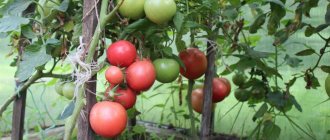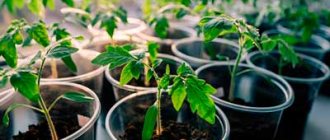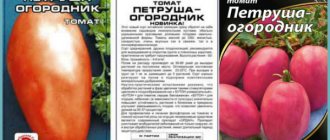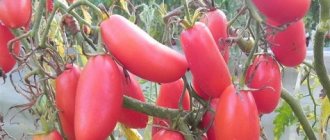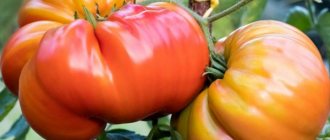Tomato Moskvich, the description and characteristics of the variety presented in this article, will become a favorite for residents of regions with short summers. Compact bushes of the Moskvich tomato variety produce an early harvest of delicious tomatoes at the beginning of summer. In addition, the variety is unpretentious in care and tolerates changing weather conditions well. The following describes all the characteristics of the variety, its advantages and disadvantages, as well as reviews from gardeners who have already grown the Moskvich tomato and share their experience.
Description and characteristics of the variety
The Moskvich tomato variety was developed by breeders at the Vavilov Institute in 1976. Many Russian gardeners liked it due to the possibility of growing it in any region of the country, since the variety is resistant to low temperatures and early fruit ripening.
- Moskvich tomatoes are cold-resistant, high-yielding varieties.
- Suitable for cultivation in regions with short and cold summers.
- Early ripening. The fruits ripen 90-95 days after emergence.
- Determinant. The bush grows 30-40 cm in height in open ground, and up to 50 cm under film cover.
- The bush is compact, standard, with an average number of leaves.
- The leaves are small, with pronounced veins, and dark green in color.
- Each cluster produces 4-6 fruits.
- Resistant to major nightshade diseases such as late blight, alternaria, fusarium and verticillium wilt.
- High yield , per 1 sq. m harvest 10-14 kg of ripe fruits.
Pros and cons of the variety
Moskvich has many advantages over other varieties of tomatoes. It is thanks to them that he has not yet lost his popularity.
Advantages of Moskvich tomatoes:
- ease of care;
- resistance to most plant diseases;
- excellent transportability;
- high productivity;
- early ripeness;
- frost resistance.
The disadvantages include the ordinary taste and small size of the tomatoes.
Fruit characteristics
- Tomatoes are small, one fruit weighs 60-80 g.
- The shape is round, slightly flattened at the stem and nose. The stalk has slight ribbing.
- Unripe tomatoes are brown-green in color. Ripe fruits become bright red.
- The skin is dense.
- The pulp is fleshy and juicy.
- There are 5-6 seed chambers inside, which contain few seeds.
- the concentration of dry substances is about 6%, sugars – up to 3%.
- The taste is rich tomato, sweetish.
- The fruits have good keeping quality and resistance to long-distance transportation.
- Tomatoes ripen well outside the bush at room temperature, maintaining their taste and external qualities.
Tomato "Moskvich": description of the variety
| Variety name | Moskvich |
| general description | Early ripening determinate high-yielding variety |
| Originator | Russia |
| Ripening period | 90-95 days |
| Form | Round or flat-round, with slight ribbing at the stalk |
| Color | Red |
| Average weight of tomatoes | 60-80 grams |
| Application | Dining room |
| Productivity of the variety | 10-14 kg per square meter |
| Features of cultivation | Standard agricultural technology |
| Disease resistance | Disease resistant |
Moskvich is a high-yielding, early-ripening variety.
The bush is determinate, compact, standard type, with moderate formation of green mass. Read about indeterminate varieties here. The leaves are corrugated, medium-sized, dark green. The fruits ripen in clusters of 4-6 pieces. Productivity is high, from 1 sq. m of plantings, you can collect 10-14 kg of selected tomatoes. Among the main advantages of the variety :
- tasty, smooth and beautiful fruits;
- good yield;
- versatility of fruit use;
- cold resistance;
- unpretentiousness to living conditions.
You can compare the yield of this variety with others in the table below:
| Variety name | Productivity |
| Moskvich | 10-14 kg per square meter |
| Morozko | 18-24 kg per square meter |
| Soyuz 8 | 15-19 kg per square meter |
| Balcony miracle | 2 kg per bush |
| Red Dome | 17 kg per square meter |
| Blagovest f1 | 16-17 kg per square meter |
| King of the Early | 12-15 kg per square meter |
| Nikola | 8 kg per square meter |
| Ob domes | 4-6 kg per bush |
| King of Beauty | 5.5-7 kg per bush |
| Pink fleshy | 5-6 kg per square meter |
Features of the variety include its demands on soil nutrition.
Description of fruits:
- Medium-sized tomatoes, weighing from 60 to 80 g.
- The shape is round or flat-round, with slight ribbing at the stalk.
- In the technical ripeness phase, the tomatoes are brown-green with a darker spot near the stalk.
- Ripe tomatoes acquire a rich red color.
- The skin is dense, but not hard, the flesh is juicy, fleshy, with a small amount of seeds.
- The amount of solids in the juice reaches 6%, sugars – up to 3%.
- The taste of ripe fruits is rich, sweetish, not watery.
To compare the weight of the fruits of this variety with other data in the table:
| Variety name | Fruit weight |
| Moskvich | 60-80 grams |
| Japanese Truffle black | 120-200 grams |
| Morozko | 50-200 grams |
| Octopus f1 | 150 grams |
| Red cheeks | 100g |
| Pink fleshy | 350 grams |
| Red Dome | 150-200 grams |
| Honey cream | 60-70 grams |
| Siberian early ripening | 60-110 grams |
| Domes of Russia | 500 grams |
| Sugar cream | 20-25 grams |
Tomatoes are delicious fresh and suitable for preparing salads, hot dishes, soups, sauces, and juices. Small fruits with thin but dense skin can be salted, pickled, and included in assorted vegetables.
Photo
Below are photos of the Moskvich tomato variety with fruits on the bushes and in cross-section.
Farmer reviews
Reviews about the Moskvich tomato are contradictory. Residents of cold regions of Russia praise it more.
Farmer reviews:
Beskrovnaya Maria, Arkhangelsk: “I have been growing Moskvich for several years now. This is one of the few tomatoes that can take root in open ground in our area. I use the fruits mainly for preservation. For fresh consumption, I grow tomatoes in a greenhouse.”
Kravets Oleg, Zelenograd: “On the advice of a friend, I tried the Moskvich tomato. An excellent variety for growing in the country. Unpretentious and needs minimal care. I can’t say that I really liked the taste of these tomatoes, but for canning it’s just the thing.”
Vasily, p. Udomlya: “I am a busy person, I work a lot. I can only go to the dacha on weekends. I want to grow my own tomatoes, but I don’t have time to bother with the garter and pick off the shoots. This year I sowed the old proven variety Moskvich. There is no need to cover it or reveal it. I fed it 3 times during the season, and the rain, of which there was a lot, watered the tomatoes for me. I thought that I wouldn’t wait for the harvest. But then the sun came out and the tomatoes began to sing together. In a word, I’m pleased with the variety.”
Features of cultivation
Moskvich tomatoes, like other early-ripening varieties, are best cultivated using seedlings. Before sowing, which takes place at the end of March, the seeds are soaked in a solution of potassium permanganate to disinfect them, then washed in warm water and soaked again, but in a growth stimulator. To do this, it is recommended to use the drug Zircon, the effect of which can be read in the article: Preparation Zircon for plants: instructions for using a growth stimulator.
The soil for planting should consist of garden soil, peat or humus, taken in equal proportions.
Seeds are sown to a depth of 1.5-2 cm, sprinkled with peat and watered with warm water. When 2-3 true leaves are formed on the seedlings, it is picked up and liquid complex fertilizer is applied.
Seedlings are planted in open ground in late May - early June. It is pre-hardened for 14 days. At first, plantings can be covered with film until they are completely strengthened and the soil is well warmed up.
The bushes are planted at intervals of 30-40 cm from each other, the distance between the rows should be at least 60 cm. Bushes of this variety do not need to be tied up or formed, but it is recommended to remove the lower leaves to improve ventilation.
More information about growing tomatoes is described in the article: Technology of growing tomatoes. Secrets of planting and care.
You might be interested in: How to properly plant tomatoes in a greenhouse: bush formation diagram, care features, photos and videos
Useful information: How to properly tie tomatoes in open ground: the best methods, step-by-step photo and video instructions
Differences between growing tomatoes in open ground and in a greenhouse
Muscovite is grown mainly in open ground; greenhouses are used for more heat-loving and fastidious varieties. There are several rules that will help keep plants healthy in extreme conditions.
The first time after planting tomatoes in open ground, they need to be covered with film at night. This will protect them from night frosts. The greenhouse structure can be removed in early June.
You can't water tomatoes in hot weather. Do this in the morning or evening.
Feedback from farmers suggests that Moskvich tomatoes grow better in open ground than in a greenhouse. In protected soil they grow in width and produce small fruits.
Video
We invite you to watch a video on how to properly plant tomatoes for seedlings:
In the table below you will find links to tomato varieties that ripen at different times:
| Super early | Mid-season | Mid-early |
| Leopold | Nikola | Supermodel |
| Shchelkovsky early | Demidov | Budenovka |
| President 2 | Persimmon | Major F1 |
| Lyana Pink | Honey-sugar | Cardinal |
| Locomotive | Pudovik | Bear Paw |
| Sanka | Rosemary pound | King Penguin |
| Pickling miracle | Beauty King | emerald apple |
Reviews from gardeners
“I planted the Moskvich variety last year. The plant pleased with the taste of its tomatoes and their large quantity on one plant. The bushes are low, compact, and do not take up much space. It is also important that care efforts are minimal; shoots do not need to be pinched or tied up. No complaints or shortcomings were identified during cultivation.”
“I liked Moskvich both in terms of its unpretentious cultivation and in terms of the resulting harvest. The fruits are smooth, tasty with juicy fleshy pulp, and there is a pronounced tomato taste. Tomatoes are good to eat fresh and as a pickling material. Small fruits weigh on average 70 grams, so they are good to use in jars of any capacity.”
Features of planting and growing
The Moskvich tomato (the description of the variety and photos confirm its short stature) should be grown in seedlings. You need to start this activity 50-55 days before planting, approximately in the second half of March.
Tomato seedlings develop better if they are picked. So it is advisable to immediately sow the seeds in a common box. It is worth using special seedling containers, which can be purchased at flower shops. Food containers with a height of up to 10 cm are also suitable. But you need to make drainage holes in them.
To sow tomatoes, you need to purchase a universal soil mixture, which is sold marked “For seedlings.”
To make the substrate yourself, you will need to combine the following components in identical parts:
- garden soil;
- sand;
- peat;
- compost or humus.
The resulting substrate will need to be disinfected so that the tomatoes do not suffer from diseases and pest larvae.
This can be done in accessible ways:
- Sterilization in the oven. Spread the soil evenly over the baking sheet in a layer up to 5 cm thick. Pour boiling water over the mixture and place in the oven, preheated to +90 °C. Sterilize the soil for 35-45 minutes.
- Treatment in a steam bath. Line a colander or sieve with gauze and place the substrate in it. Place the structure over a container of boiling water and close the lid. Sterilize the soil for 80-90 minutes, remembering to stir it occasionally.
- Sterilization with potassium permanganate solution. Dissolving 3 g of crystals in 10 liters of water. Pour the solution generously over the soil, and after 30 minutes. Place it on a sieve to drain excess moisture.
It is also better to process and germinate planting material before sowing. Then the seedlings will receive protection from diseases and pests, and the harvest will ripen earlier.
And you should prepare the seeds according to the following instructions:
- Prepare a solution of the drug “Fitosporin-M Tomatoes” (1.5 g per 1 liter of water). Soak the seeds in it for 30-60 minutes.
- Rinse the grains and place them on a saucer covered with a cloth. Wet the material at a temperature of +30…+35 °C.
- Leave the seeds in a warm, shaded place to germinate. As it dries, spray the fabric with water.
You need to start sowing seeds when sprouts form on them.
Sowing
The algorithm for sowing tomatoes is simple and consists of simple steps:
- Sprinkle the bottom of the planting container with a layer of drainage 1 cm thick. Use small pebbles, sand or crushed foam. Fill the container with sterilized substrate so that there is a gap of 2 cm between its surface and the edge.
- Level the soil, water it and make furrows 1.5 cm deep.
- Plant the seeds one at a time, maintaining an interval of 2 cm between them. Place the sprouted grains with the sprouts facing up. Sprinkle the planting material with dry soil. The thickness of the layer should not exceed 2 cm. If possible, lay a layer of snow on the ground. This will speed up germination and harden future seedlings.
- Cover the planting with a lid, glass or transparent film. Send to a shaded place with a temperature of +22…+25 °C. until seedlings appear, ventilate the greenhouse daily and remove condensation from the shelter when it appears. Regularly spray the soil with warm water from a fine spray bottle, preventing it from drying out.
- After emergence of seedlings, remove the cover. Move the planting to bright but diffused lighting. Near it, maintain a temperature of +18...+20 °C during the day, and about +16...+17 °C at night.
Seedling care
Regular but moderate watering is the basic rule for growing seedlings. To irrigate tomatoes, it is better to use only settled and warm water. And it should be poured in when the top layer of soil dries out.
Cloudy days often occur in spring. During such periods, it is better to supplement the seedlings with photo lamps so that the length of daylight for the plants reaches at least 12 hours.
You will need to pick up the saplings when they have 2 true leaves (approximately 10-14 days after emergence). Peat pots are ideal for this procedure. You can also plant seedlings in ordinary plastic glasses with a volume of 0.5 liters. But you need to drill drainage holes in them. It is also advisable to pour expanded clay, sand or pebbles on the bottom in a layer of 1 cm.
10-14 days after picking, the seedlings need to be fed. It is worth adding liquid solutions of nitrophoska, azofoska, and infusion of chicken manure.
The following drugs are also suitable:
- "Agricola for vegetables."
- "Fertika Lux".
- "Potassium humate."
Fertilizing needs to be done after another 10-14 days.
It is worth planting tomato seedlings in the garden bed no earlier than the second half of May, when the risk of return frosts has disappeared and the soil has warmed up well. By this time, at least 4-8 leaves should have formed on the seedlings. It’s even better if the plants form one inflorescence.
It is important to harden off the seedlings before planting. This process must begin 14-15 days before the event. First you will need to take the plants outside and leave them in a shaded and windless place for 20-30 minutes. The event should be repeated daily. Moreover, it is necessary to constantly increase the duration of such sessions by approximately 30-45 minutes. In bad weather, it is better to leave the seedlings indoors, but you should open the window or window slightly to continue hardening.
Soil and planting algorithm
The Moskvich tomato, the photo of which is given in the article, should be grown in illuminated, open areas. According to the description of the variety, lowlands and places with close groundwater are not suitable for it.
When choosing a site for tomatoes, you must remember the rules of crop rotation. It is not advisable to grow tomatoes in one place for 2 years in a row, or plant them after eggplants, peppers, and potatoes. This will provoke the development of diseases. And it is better to choose places for the crop where there used to be zucchini, corn, cabbage, and legumes.
The bed for tomatoes needs to be prepared at the end of autumn.
Instructions:
- Dig the area to a depth of a spade. In the process, remove the remains of the previous harvest, weeds, and debris.
- Add to each square. m of soil, 10 liters of humus, 25 g of superphosphate, 100-150 ml of wood ash.
- In the spring, dig up the soil again, bringing it into the square. m 25 g of ammonium sulfate, 5 kg of compost. Thoroughly loosen the soil and level it with a rake.
At least 20 days must pass between the last application of fertilizer and planting of tomatoes.
Event algorithm:
- Dig holes with a depth of 25-30 cm. Keep an interval of 40 cm between them, the distance between rows is 50 cm. Install supports or stretch a trellis near the bed.
- Remove the seedlings from the containers along with the earthen lump. It will be easier to do this if you water the seedlings well 1-2 hours before planting. It is better to simply cut plastic glasses. If the seedlings are planted in peat pots, then skip this step.
- Pour 5-7 liters of warm water into the recesses. When the moisture is absorbed, install the plants one by one.
- Gradually fill the voids with soil so that the stems are buried down to the cotyledon leaves.
- Lightly compact the surface of the bed.
If there is a risk of return frosts, the bed should be covered with film or lutrasil. You can remove the cover after 1-2 weeks, when the plants take root.
Trimming
The Moskvich tomato is a low-growing variety. And it doesn’t need to be pinched or shaped. But it is worth removing the lower leaves to prevent thickening of the bushes. You should also tie the stems to supports, otherwise they will fall under the weight of their own crop.
And this will increase the risk of developing late blight.
Care
Tomatoes of the Moskvich variety do not tolerate excess moisture well, but prolonged drought is also destructive for them. Therefore, plants need to be watered every 7-10 days. But watering should be plentiful, and about 3-4 liters of water, heated under the sun until warm, should be poured under each plant.
Water should be poured strictly at the root, trying not to get on the leaves and stems. Irrigation should be carried out in cloudy weather, early in the morning or late in the evening. Otherwise, under the influence of the sun, the water will become very hot and cause a burn to the roots of the crop. In addition, watering during the day quickly evaporates moisture, without benefiting the plants.
1-2 hours after watering or precipitation, the soil should be loosened. Otherwise, it will become denser, and the roots will receive less oxygen, which will negatively affect the yield. The soil should be loosened under the bushes and between the rows. During the procedure, it is also necessary to weed out weeds, since they are the main carriers of diseases and pests.
To reduce the maintenance of a tomato bed, its surface should be sprinkled with a layer of straw or compost. Organic matter will slow down the evaporation of moisture and prevent soil compaction. So you will need to water and loosen the garden bed less often. As the mulch decomposes, it will add beneficial elements to the soil. But it is necessary to regularly update the layer of organic matter, as it is washed away with irrigation and rainfall.
To increase productivity, tomatoes need to be fed according to the following scheme:
- 2 weeks after planting the tomatoes, feed them with a mixture containing nitrogen. A solution of bird droppings or mullein is suitable. Mineral fertilizers should use nitroammophoska, superphosphate
- Feed crops during fruit set using phosphorus-potassium complexes. Monopotassium phosphate and nitrophoska are suitable.
- Apply fertilizer while tomatoes are ripening. Use potassium-phosphorus fertilizers. A solution of wood ash is suitable for organic matter. It is better to use potassium monophosphate as a mineral fertilizer.
Sometimes it is useful to carry out foliar feeding. For them, it is worth using a solution of special preparations, such as “Ovary” or “Tomaton”, or boric acid.
Tomatoes need to be watered thoroughly before fertilizing. It is advisable to carry out the procedure on a cloudy day. In clear weather, it is better to feed the plants early in the morning or at sunset. Otherwise, the drugs will cause a burn at the roots.
Diseases and pests
The Moskvich tomato (the description of the variety and photos indicate its productivity) does not have absolute resistance to disease. And if you do not properly care for the plant, its natural protection will weaken.
Then the tomato will become susceptible to the following diseases and pests:
| Name | How to recognize | How to treat |
| Late blight | The disease develops with frequent temperature changes and high air humidity. When infected, fruits, stems and leaves become covered with brown spots. | It is very difficult to cure late blight. But the disease can be easily prevented if, after planting, the bushes are treated with Bordeaux mixture for prevention. In the early stages of infection, the drugs “Fitosporin” and “Barrier” help. |
| Gray rot | A fungal disease that develops when there is excess nitrogen in the soil and high humidity. It can be recognized by the grayish “fluffy coating” covering the stems, leaves and fruits | To treat the disease, you need to use fungicides such as “Maxim”, “Fundazol”, “Trichodermin”. At the initial stage, you can use folk remedies, such as a solution of baking soda, green soap or boric acid. |
| Dry spotting | A fungal disease that often develops at elevated temperatures. As a result of infection, the above-ground part of the plant dries out and the fruits become covered with dark spots. | For treatment, you need to spray the planting with preparations containing copper (“Abiga-Pik”, “Hom”, “Oksikhom”). |
| Spider mites | The appearance of these small, inconspicuous pests is indicated by a thin sticky web that can be found under the leaves. Insects also pierce the leaves, feeding on their juice, which leads to the formation of black and brown spots. | If there are few pests, then it is enough to spray with an infusion of garlic or onion peels. The insecticides “Aktellik” and “Fufanon-Nova” help against a large colony. |
| Thrips | Small bugs of gray, brown or black color. They leave white dots and a black powdery coating on the leaves. | A small colony can be driven away using an infusion of marigolds or garlic. If there are a lot of pests, then it is better to use the drugs “Fufanon”, “Aktellik”, “Karbofos”. |
| Colorado beetles | Large beetles that can be recognized by their characteristic striped color. Pests and larvae feed on leaves, shoots and even fruits, and can lead to the death of the plant. | In a small area, it is better to collect pests with your hands and dust the bushes with wood ash. On large beds, it is advisable to use insecticides “Aktara”, “Fitoverm”, “Colorado”. |
| Slugs | Shellless snails that feed on the ground parts of tomatoes. Plants attack more often at night. They leave behind shiny, sticky stripes that can be used to identify pests. | It is worth scattering crushed eggshells or wood ash between the rows. They will make it difficult for pests to move. You can also use the Fitoverm insecticide. |
Wintering
Tomatoes of the Moskvich variety are annual plants, and it is not advisable to make a shelter for them.
Harvesting
Tomatoes of the Moskvich variety ripen quickly by the middle - end of July. And for consumption or making juices, ketchup, they should be removed at full ripeness, when the fruits acquire a bright red color.
You cannot keep tomatoes on the bushes for too long, as they will become loose, mealy, and their taste will noticeably deteriorate. To prevent this from happening, you need to harvest the crop every 4-6 days. It is better to carry out this event in the evening or in the morning, since the fruits collected at lunch quickly wither and lose their presentation.
You can also harvest tomatoes when they are ripe (brown). This will speed up the formation and ripening of the next batch of crops. And unripe fruits quickly ripen on the windowsill at a temperature of +28…+30 °C.
Storage
Tomatoes are not vegetables intended for long-term storage.
But you can significantly increase their keeping quality if you follow some rules:
- It is better to send unripe fruits collected at the end of summer for storage. They ripen well and quickly as soon as you move them to a warm and bright place. It is better to cut them with brushes along with the stalks.
- It is better to keep the harvested crop in a room with a temperature of + 3 ... + 5 ° C. And it is important that the sun's rays do not fall on it. A dry cellar or basement is ideal.
- You can increase the keeping quality of tomatoes if you need to place them side by side in boxes covered with paper. It is also advisable to sprinkle the crop with straw, which will absorb excess moisture.
During storage, you should check the tomatoes daily and remove ripe and spoiled fruits.
Advantages and disadvantages
When choosing tomatoes, gardeners note a lot of advantages of Moskvich. It can withstand cold, is resistant to temperature changes, and is easy to care for. The variety has the following advantages:
- good seed germination;
- high productivity;
- immunity to disease;
- excellent taste.
Among the disadvantages are:
- demands on soil composition;
- intolerance to drought;
- the need to tie up bushes.
Advantages and disadvantages
Studying the advantages, disadvantages and reviews of Moskvich tomatoes, we can conclude that this variety is ideal for regions with cool climates. And thanks to the unpretentiousness of the bushes, even inexperienced gardeners can get a decent harvest.
Reviews from gardeners
Both beginners and experienced gardeners like Muscovite. It is especially appreciated by residents of the northern regions.
Nikolay, Vologda: “I’m pleased with the unpretentiousness of the Moskvichka. I can’t devote much time to the garden, but I grow tomatoes every year. This variety does not require special attention, which makes me very happy. “Tomatoes are very tasty, every year we can them for the winter and eat them fresh.”
Lidia Mikhailovna, Saratov: “I have long heard from experienced gardeners about the Moskvich tomato. I decided to try it at random and now I prefer this variety to all the others. A very productive tomato, I recommend it to everyone!”
Elena Korotkova, Novodvinsk: “I live in the northern region. In our conditions it is not easy to grow a tomato crop. I found a variety called Moskvichka that is resistant to our cold weather. For me, growing tomatoes without greenhouses was a real discovery. I will never give up this variety!”




